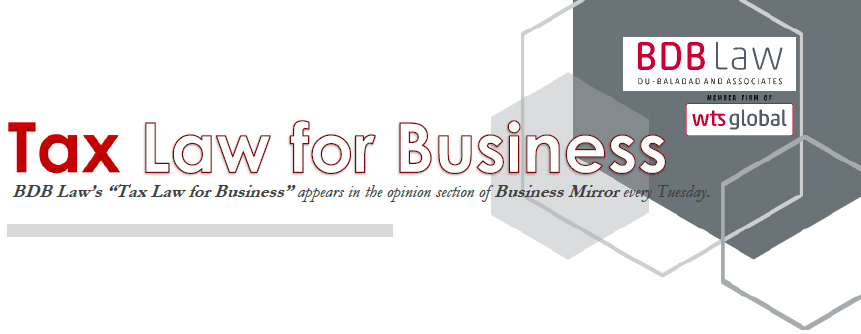
Wishlist of Clarifications for the Digital Services Tax
By: Atty. Jomel N. Manaig
"Hope is not lost. Some of the issues hounding the RR of the VAT on digital services may still be clarified through the issuance of Revenue Memorandum Circulars (RMC). Should the BIR be so thoughtful as to issue an RMC or two to clarify the issues in the implementation of the VAT on digital services, I hope that it would include these issues"
 Atty. Jomel N. Manaig +632 8403-2001 loc. 140 |
Just a day shy from the 90-day timeline provided under the law imposing VAT on digital services, Revenue Regulations (RR) No. 3-2025 was issued to provide the implementing rules and regulations for the said law.
A quick visit to the recent past would remind us that the draft RR was circulated to the public for consultations sometime in November 2024. Comments, as well as suggested revisions, were subsequently communicated to the BIR (including those proposed by yours truly). While some revisions made it to the final version of the RR, it was largely the same as when the initial draft was first circulated. Effectively, some issues raised during the public consultations were not readily addressed in the final RR.
 Nonetheless, hope is not lost. Some of the issues hounding the RR of the VAT on digital services may still be clarified through the issuance of Revenue Memorandum Circulars (RMC). Should the BIR be so thoughtful as to issue an RMC or two to clarify the issues in the implementation of the VAT on digital services, I hope that it would include these issues:
Nonetheless, hope is not lost. Some of the issues hounding the RR of the VAT on digital services may still be clarified through the issuance of Revenue Memorandum Circulars (RMC). Should the BIR be so thoughtful as to issue an RMC or two to clarify the issues in the implementation of the VAT on digital services, I hope that it would include these issues:
FIRST: Clarification as to the extent of digital services.
In my December 2024 article “Riddle me this: What are digital services?,” I made a focused analysis on what may be considered as digital services for purposes of imposing VAT. To shorten my otherwise detailed discussion in that article, suggestions were made to include parameters to distinguish actual digital services from traditional services conducted using modern technology.
While a few words were changed in the final version of the RR regarding the definition of digital services, it is still far from setting things straight. Confusion and probable misapplication of the law is still within the realm of possibility.
SECOND: Automated registration for nonresident digital services providers.
The law required a simplified automated registration system for nonresident digital service providers (NDSP). The RR responded to this requirement by stating that a VAT on Digital Services (VDS) portal shall be used for such registration.
But what is this VDS portal? While there is still no information released for this portal, it is interesting to note that the BIR Online Registration and Update System (ORUS) portal appears to be accepting online registration of NDSPs. The ORUS portal itself expressly mentioned NDSPs.
So is the VDS portal and the ORUS portal one and the same? This needs to be clarified since the RR only gave NDSPs sixty (60) days from the RR’s effectivity to register. In other words, the clock is ticking. Even if the NDSPs want to register, without proper guidance, how can they?
THIRD: The reverse charge mechanism.
The reverse charge mechanism is expressly recognized in the law. A new subsection (D) was even inserted in Section 114 to codify this new mechanism. However, the provisions of the RR would suggest a striking similarity between the reverse charge mechanism (under Section 114(D)) and withholding VAT (under Section 114(C)).
Is the reverse charge mechanism the same as withholding VAT? If it is just the same, why the need to create a whole new subsection devoted to it?
It should also be noted that the reverse charge mechanism is a staple in other jurisdictions. However, it would seem that our reverse charge mechanism is very much different from how other jurisdictions practice it since we actually require buyers to withhold and remit the VAT. In other jurisdictions, the withholding of the VAT payable and the recognition of the related input tax is done simultaneously. Ultimately, there is no remittance to speak of.
Further, as far back as May 2024 in an article entitled “Digital services tax: An ASEAN comparison,” I made certain observations on how our digital services tax is shaping as compared to our regional counterparts. The comments I made then as to the reverse charge mechanism still rings true up to this day.
I myself hope that the issues above, and those that we do not have the space to discuss, would still be addressed in an RMC. To inspire all of us to push for clarifications, let’s remember that we are dealing not only with resident digital service providers but also with nonresidents. Our laws, rules, and regulations are a representation of our country. Making sure that these are clear and free from ambiguities is the legal equivalent of putting our best foot forward.
The author is a partner of Du-Baladad and Associates Law Offices (BDB Law), a member-firm of WTS Global.
The article is for general information only and is not intended, nor should be construed as a substitute for tax, legal or financial advice on any specific matter. Applicability of this article to any actual or particular tax or legal issue should be supported therefore by a professional study or advice. If you have any comments or questions concerning the article, you may e-mail the author at This email address is being protected from spambots. You need JavaScript enabled to view it. or call 8403-2001 local 140.




